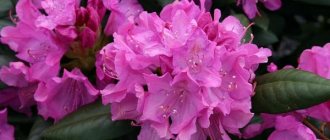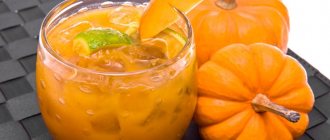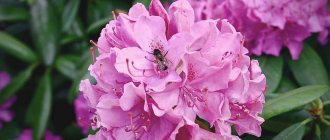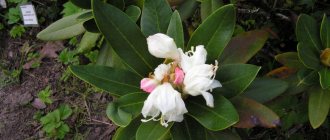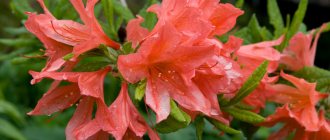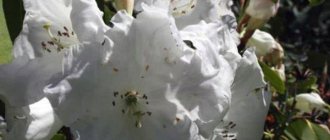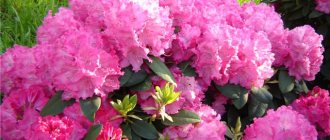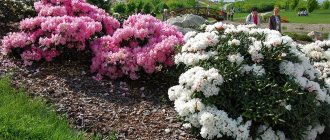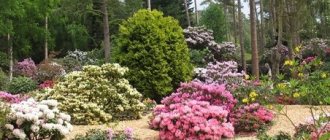Daurian rhododendron or wild rosemary is a perennial, beautifully flowering shrub. The plant belongs to the heather family and reaches a height of 2-3 m. The bush is decorated with a highly branched, spreading crown, which in mid-spring is covered with large purple flowers. Having once seen a flowering shrub in natural conditions, everyone wants to plant an unpretentious plant in their own plot.
Description of Daurian rhododendron
Dahurian rhododendron is prone to strong branching. The plant forms from 20 to 50 vertical, thin shoots colored brown.
Flexible branches are covered with oval, glossy leaves, painted in dark olive color. The leaf plate is small, up to 4 cm in length and no more than 1 cm in width. The plant has one peculiarity - foliage appears only after flowering.
At the end of April, the bush is covered with brightly saturated flowers, up to 5 cm in diameter. The color of the petals can be scarlet, purple, snow-white or lilac, depending on the variety. The flowers open simultaneously and are located at the tips of the branches and in the axils of the leaves. After flowering, a small seed capsule is formed.
Important! During flowering, the plant emits a strong, pleasant aroma that attracts bees. Therefore, Daurian rhododendron is considered a good honey plant. But honey collected from the bush has laxative and hallucinogenic properties.
Under natural conditions, Dahurian rhododendron grows in deciduous and pine forests. During flowering, the place becomes fabulous and magical. Tourists, seeing such magical beauty, do not hold back and tear off flowering branches and even dig up young growths for planting in the country, not suspecting that by doing this they are causing serious damage to the species. For this reason, Daurian rhododendron was included in the Red Book and is protected by law.
Daurian rhododendron is widely used for gardening. Thanks to the medium-sized shrub, you can improve and diversify your landscape design. The plant looks good:
- in rock gardens;
- with coniferous plants;
- next to juniper and decorative fern;
- in group and single plantings;
- Flowering shrubs can be used to make a beautiful hedge.
Important! Daurian rhododendron begins to bloom from the age of 3.
Planting shrubs
Planting and caring for Daurian rhododendron requires careful selection of location and accuracy, but in general the plant can be called unpretentious.
Site selection and soil preparation
The location must be chosen especially carefully, since the plant can live up to 50 years and does not take too kindly to frequent transplants. Therefore, the optimal location would be a illuminated area, but not in direct sunlight, protected from the wind. The northern side of the site or the vicinity of coniferous plants is suitable. It is optimal to choose a flat surface where there is no stagnation or accumulation of ground or other water. The soil should not be heavy or dense, the optimal acid-base balance is from 4.5 to 5.
Important! Transplantation is best done in early spring
Pit preparation
It is necessary to add mineral fertilizer to the soil, and then prepare the holes: their width and depth should be approximately 60-70 cm. The distance between the bushes varies depending on the plant variety and can range from 70 cm to 2 m
When planting, it is important to monitor the root collar; it should remain a couple of centimeters above the surface
After planting, the plant is watered and mulched with pine needles or peat.
The beauty of wild rosemary is the best reward for all your hard work.
Care
In early spring and after flowering, mineral fertilizers are applied, the soil is not loosened deeply, and weeds must be removed. If there are signs of lack of moisture, watering is necessary, and it is advisable to maintain a layer of mulch all year round. In the first year after planting, wild rosemary is not allowed to bloom, this allows you to grow a stronger and more developed plant.
Important! Pruning is carried out either in early spring or after flowering and is carried out in compliance with the standard rules for this procedure. If rhododendron is cared for correctly, it is not very prone to disease.
However, at the first signs, the best solution would be to remove all affected shoots and burn them, and treat the bush depending on the manifestations of the problems.
If rhododendron is cared for correctly, it is not very prone to disease. However, at the first signs, the best solution would be to remove all affected shoots and burn them, and treat the bush depending on the manifestations of the problems.
Ledum is quite frost-resistant and tolerates cold temperatures down to −45°C. The feasibility of covering its root system for the winter is calculated based on the climatic conditions of the growing zone, however, if necessary, standard methods of covering are used, according to agricultural technology, with high hilling at the base of the root, leaves and spruce branches. The shoots can be bent to the ground.
Dahurian rhododendron is a very beautiful and distinctive plant with spectacular flowers. The culture has beneficial properties and cures many diseases. It can be planted in the northern zone of Russia, as it easily tolerates frost, but requires special care.
When does Dahurian rhododendron bloom?
Daurian rhododendron begins to bloom lushly at the end of April and continues until the second half of June. There are varieties that bloom much earlier. The flowers of the bush are bright, the color depends on the variety, but generally the bush turns lilac-pink every spring.
Cultivated Dahurian rhododendron is distinguished by lush and long-lasting flowering, which lasts up to 50-60 days. Funnel-shaped, bell-shaped flowers are located exclusively on the upper part of the shoot.
Medicinal properties of Daurian rhododendron
Young leaves and flowers of rhododendron are used as medicinal raw materials, which are dried under a canopy at a temperature of + 50-60 °C.
Medicines prepared from the flowers and leaves of rhododendron dahurianum can be beneficial and harmful to the body. Preparations prepared from the plant have bactericidal, diuretic, antipyretic, sedative and analgesic effects. Infusions and decoctions prepared on the basis of rhododendron relieve swelling, relieve shortness of breath, palpitations, and lower blood pressure.
Medicinal properties of Daurian rhododendron:
- Therapeutic baths help with neuroses and radiculitis.
- An infusion of flowers is recommended as a sedative and hypnotic. It can be used for colds and cardiovascular diseases.
- The decoction is prescribed for diseases of the internal organs and is used as a diuretic for urolithiasis.
- A tincture of flowers and leaves relieves joint pain.
- Rhododendron dahuriana tea helps with migraines and sore throats.
Important! Preparations based on Dahurian rhododendron are not recommended for use during pregnancy and lactation, or for people with tissue necrosis and chronic kidney disease.
Varieties of Daurian rhododendron
Daurian rhododendron is a medium-sized, perennial shrub. Thanks to the painstaking work of breeders, many varieties of beautiful flowering shrubs have been developed, which differ in shape, size and color of flowers. The most famous:
- April Dominance is a low-growing variety with double, soft pink flowers. The plant has the earliest flowering, with the first buds appearing in mid-April.
- April Snow is a low-growing, winter-hardy variety with snow-white, double flowers. Flowering is early, occurs in mid-April.
- Elite is a beautiful hybrid bred by crossing Daurian rhododendron with Carolinian rhododendron. Daurian rhododendron elite is a tall shrub, reaching a height of 4 m. The variety is frost-resistant and fast-growing. At the end of April, the plant forms a lush crown of bright pink flowers.
- Chess is a slow-growing dwarf hybrid, up to 1 m high. The plant produces small, bright pink flowers that bloom in the first half of summer.
In culture[edit | edit code]
Known in culture since 1870. The advantage of the main type is its high winter hardiness. Light-loving, feels good in combination with sparsely growing larches, on the edges and small clearings. In the climatic conditions of Latvia, it blooms very early - in April, but in winters with frequent thaws, the flower buds freeze. In warm weather, flowering is observed even in winter. In regions with mild winters, during thaws, the buds begin to bloom, and then, even at slightly below zero temperatures, freeze out [3]. Has the form (f. sempervirens
) - with dark green, evergreen leaves, darker, purplish-violet flowers.
In GBS since 1947. At the age of 20 years, the height of the bushes reached 0.7-2 m. Shoot growth occurs from mid-May to the second half of July. The average annual growth is 6-10 cm (maximum - 12 cm). First flowering and fruiting from 3 years. The earliest date for the first blooming of the Daurian rhododendron flowers was noted on April 19, 1966, the latest was May 11, 1965. Flowering from late April to mid-May, for approximately 18 days (±4 days). In some years (1957 and 1958), only single flowers bloomed; the minimum flowering period was 8 days. With massive and abundant flowering, the observed sample was in bloom for 32 days (1959). In 1970, the Dahurian rhododendron did not bloom at all, since all the flower buds were damaged by the frost of the previous winter. The first flowering was noted at 3 years. Secondary flowering does not occur annually in mid-September or October, less often in November. The earliest date of spring flowering was observed on May 3, 1957, the latest was on May 31, 1971. The earliest leaves bloomed was April 27, 1966, the latest was May 18, 1965. The average date for the onset of autumn leaf color is August 25 (±5 days). The duration of the growing season of Daurian rhododendron is, according to long-term data, 135 days (±2 days). The fruits ripen in October; seed viability 94%. In Moscow conditions, winter hardiness is high. The shoots become lignified by 100% [5] [6]. In the conditions of the Nizhny Novgorod region it is relatively winter-hardy. In severe winters, the ends of annual shoots sometimes freeze. Damaged by spring frosts. In warm winters with thaws, massive plant death is observed. The seeds ripen [7].
Daurian rhododendron seeds are stored in paper bags or in tightly sealed glass containers in a dry, unheated room. At the same time, seed germination remains for 3 years. Seeds do not need stratification. They are sown in December - February in greenhouse conditions at 18-20 ° C without embedding in the soil [5]. Seeds germinate in 20-25 days. Seeds of the same species do not germinate at the same time. When grown in greenhouses, individual seedlings begin to bloom in the third year. Four to five year old seedlings can be planted in the garden beds in the spring. Four-year-old seedlings bloom and branch profusely. The height of the plants by this time reaches 0.5-0.7 m. A soil mixture of sand and peat in equal quantities (1:1) is recommended. Daurian rhododendron propagates well from cuttings. When cuttings were treated for 15 hours in indolylbutyric acid (0.01%) and at the same time when cuttings were treated with succinic acid (0.02%), the highest percentage of rooting was observed. Under the same experimental conditions, cuttings from the apical (epical) part of the shoot give the highest percentage of rooting than from its lower (basal) part. Summer cuttings of Dahurian rhododendron give 100% rooting in a greenhouse with artificial fog without heating and without treatment with stimulants. Rooted cuttings in the fall should be planted in boxes filled with a soil mixture of the following composition: acidic peat, pine litter, leaf soil, sand in a ratio of 2:1:2:1. It is better to store them in a basement or greenhouse with a reduced temperature of up to 5 ° C in the autumn-winter period. At the end of May or at the beginning of June, rooted cuttings can be planted in open ground in a bed with the same soil mixture or with double the content of acidic peat, and the leaf soil can be replaced with turf. Seedlings must be shaded with shields from direct sunlight. After keeping the seedlings in the nursery for two to three years, when the plants have good growth and are most decorative, they can be planted in a permanent place [8].
Read also: How to properly prune actinidia in the fall
The plant was introduced into the countries of Europe and North America, where hybrid varieties were created and cultivated as ornamental garden plants. One of the most widespread are the varieties of the PJM group, bred by Edmund Mezitt in 1939 as a result of crossing the Daurian rhododendron with Rhododendron minus var. minus [9] [10] .
Growing conditions for Daurian rhododendron
In order for Dahurian rhododendron to delight with its flowering for a long time, it is necessary to create favorable conditions for its growth and development. Since the bush grows in one place for about 50 years, it is necessary to approach the choice of location with all responsibility. Daurian rhododendron prefers:
- a well-lit place, without direct sunlight and drafts;
- Rain and melt water should not stagnate on the site;
- groundwater should not be located superficially;
- Daurian rhododendron prefers to grow in nutritious, loose soil with high acidity;
- The plant should not be planted near buildings, as they create long-term shade.
Use of the plant
It is practical to use this plant in a hedge, including in combination with coniferous trees. Growing rhododendron in your own garden is not difficult. The efforts spent will pay off handsomely in the spring, during rapid flowering.
In addition to aesthetic pleasure, you can get gastronomic pleasure from rhododendron. Ledum contains fructose and essential oils, which allows the flower petals to be used in cooking. They are added to salads. The dish acquires a unique aroma and sweetness.
Planting and caring for Daurian rhododendron
Daurian rhododendron is unpretentious in cultivation and care. If you follow agrotechnical rules, the shrub will delight you with abundant, lush flowering, which begins in late April.
Selection and preparation of a landing site
Before planting a young rhododendron, it is necessary to prepare the place 3 weeks in advance. Preparing the site for planting:
- At the selected location, dig a planting hole measuring 50x70 cm.
- The bottom is covered with expanded clay and 10-15 cm of broken brick.
- When mass planting rhododendron darsky, the planting rate should be 2 plants per 1 square meter. m.
- Next, the hole is filled 1/3 with nutritious soil. If the soil is clayey, then use a purchased substrate for azaleas or one prepared independently from peat, leaf turf and pine needles mixed in a ratio of 2:3:1. 70 g of complex mineral fertilizers are added to the prepared soil.
- The hole is covered with dark polyethylene and left for 2 weeks.
- After the earth has warmed up well, the film is removed and the hole is shed until the earth absorbs moisture.
Seedling preparation
It is better to purchase Dahurian rhododendron seedlings from a nursery at 2-4 years of age. Before purchasing, you must carefully inspect the seedling. You need to choose strong, viable young plants that have intact roots without signs of rot and healthy, brightly colored shoots. The seedling should not show signs of rot or mechanical damage.
If the seedling was purchased with a closed root system, it should be watered generously before planting. And specimens with bare roots are kept for 12 hours in water at room temperature with the addition of a root formation stimulator.
Rules for planting Daurian rhododendron
A seedling with a straightened root system is installed in the prepared hole. The plant is carefully sprinkled with nutritious soil, compacting each layer so as not to leave any air space. The planted plant is watered abundantly, and the tree trunk circle is mulched. Pine sawdust, straw, and leaves are suitable as mulch. It will stop the growth of weeds, oxidize the soil, retain moisture and become an additional organic fertilizer.
Important! For a properly planted seedling, the root collar should barely protrude above the soil surface.
Daurian rhododendron is easy to care for. To obtain lush and abundant flowering, you must follow simple rules:
- watering;
- feeding;
- weeding;
- pruning;
- preparation for winter;
- prevention from diseases.
Important! Due to its cold resistance, Dahurian rhododendron can be grown in the North-Western region and in the Moscow region.
Watering and fertilizing
Watering rhododendron is done as the top layer of soil dries. In hot, dry summers, irrigation is carried out 2-3 times a week with warm, settled water. Hard water negatively affects the root system, so experienced gardeners recommend softening it with citric acid or vinegar (100 g per bucket of water). To ensure that the plant is saturated with moisture, up to 20 liters of water are used for each bush.
Important! To maintain soil acidity, sulfuric acid must be added to the water.
After watering, shallow, careful loosening and removal of weeds is done. Weeds take away nutrients and are carriers of diseases and pests.
For abundant and lush flowering, root feeding is necessary:
- The first time 10 kg of rotted manure or compost is applied at the beginning of the growing season. Organic matter is necessary for growing green mass, for the formation of buds and the formation of flower buds for next year.
- The second feeding is carried out immediately after flowering. To do this, use phosphorus-potassium fertilizers diluted strictly according to the instructions.
Important! When using complex mineral fertilizers, it is necessary to give preference to those that contain a minimum amount of chlorine, lime and phosphoric acid.
Trimming
Dahurian rhododendron does not need to form a crown, since the plant has a genetic basis for the development of the correct decorative form. Pruning is carried out for sanitary and anti-aging purposes. The shoots of old bushes are shortened, leaving a length of 30-40 cm from the soil surface.
After flowering, all faded brushes are promptly removed. Since they spoil the decorative effect and interfere with abundant growth and future flowering. Pruning must be done while keeping the axillary bud on the top leaf. To avoid the addition of diseases, pruning is carried out with a sharp, sterile instrument, and the cut areas are treated with brilliant green or covered with garden pitch.
Preparing for winter
Dahurian rhododendron is a frost-resistant crop that can easily withstand frosts down to -40 °C. An adult plant does not need shelter, except for abundant watering, mulching around the trunk and fertilizing with phosphorus-potassium fertilizers. In order not to lose a beautifully flowering variety, it is necessary to cover only the young seedling for 2-3 years, until the bush gets stronger and grows a powerful root system. For this:
- the seedling is covered with peat or rotted compost, while covering the root collar;
- pour plenty of warm, settled water;
- fed with wood ash;
- the crown is tied with agrofibre or roofing felt;
- The cover is removed in the spring, only after the soil has warmed up.
Selection and purchase of seedlings
Do not order seedlings from afar. They must be grown in your region - this is the kind of shrub that will quickly take root on the site and successfully overwinter. Many Russian gardeners have already been burned by buying varietal bushes brought from Poland or Holland. The seedlings were sold in bloom and looked impressive. They immediately took root in the yards, but the very first winter showed these “warm-blooded” plants where the crayfish spend the winter.
The thing is that in Europe many seedlings are grown hydroponically. This is a good technology; in warm countries, seedlings even winter outside after this. Here they will freeze to death. Even growing such a bush in a garden pot will not save you - if you move it indoors for the winter, the plant will begin to suffer from dry air and will wither anyway.
An ideal seedling should be from 2 to 4 years old. Those grown from seeds should be at least 15 cm tall, and those obtained by cuttings should be about 25 cm tall.
Planting rhododendron in open ground
- Site selection. Despite the fact that rhododendrons grow with might and main in Russian forests, they should not be considered indestructible plants. In order for the tree to delight with lush and bright flowering, the place for it must be chosen carefully. Firstly, there should be no drafts there. Secondly, the lighting should be moderate - not too shaded, but at midday the sun should avoid this place. And thirdly, it should not be lowland (the depth of groundwater is from 2 m).
- Priming. This is how it is laid down by nature - the more luxuriantly a crop blooms, the more nutritious soil it needs. In addition, the substrate should be light, quickly absorbing melt and rain water. Rhododendron likes high acidity.
- Plants are neighbors. Some trees absorb a lot of nutrients and moisture from the soil. Do not plant rhododendron in their shade, the bush will not be able to resist such a strong competitor and will wither. The enemies of this culture include: birch, linden, maple, weeping willow, alder. If the tree is already growing on the site, a large piece of dense covering material can be placed in the rhododendron planting hole, insulating the roots of the plant from the sides and bottom.
- Time. This crop is planted in the spring (if the seedling has open roots), or from spring to early autumn (if the plant is grown and purchased in a container - a pot).
Dimensions of the planting hole for this shrub: 70 cm deep and 50 cm wide. The hole is dug either in the fall, or at least a month before planting. Drainage is placed at the bottom at 15-20 cm
It is important that no lime or other deoxidizing substances get inside when working.
The soil removed from the hole is enriched with coniferous litter, deciduous soil and peat. Instead, you can buy a ready-made bag of soil for azaleas. After this, add complex mineral fertilizer (70 g per bush).
Plant tall varieties at two-meter intervals. Short ones - 75 cm from each other.
After planting the rhododendron, the soil is thoroughly compacted, and then the bush is generously watered. If you want to mulch the area, use pine chips or dry pine needles. This mulch additionally acidifies the soil.
Reproduction of Daurian rhododendron
When you purchase one plant and see its beautiful flowering, you always want to propagate it in order to turn your garden plot into a spring, blooming carpet. It is not difficult to root Dahurian rhododendron; even a novice gardener can handle it. There are 3 methods of propagation: seeds, cuttings and offshoots.
- Seed propagation is a labor-intensive and time-consuming task. Therefore, it is not suitable for beginner gardeners.
- Layering is an affordable and effective method of propagation. In spring or autumn, the strongest, healthiest shoot located closer to the ground is selected from the bush. The lower leaves are removed, the upper ones are shortened by ½ length. The prepared shoot is placed in a trench, leaving the top above the ground surface, to a depth of 4-6 cm. To speed up the process of root emergence, the ground must be moistened and mulched. In the 2nd year, the young plant can be separated from the mother bush and planted in a permanent place.
- Cuttings - in June, after flowering, cuttings 10-15 cm long are cut. The lower leaves of the planting material are removed, and the cut is made at an acute angle. The rhododendron cuttings are placed at an angle of 30° in nutrient soil and placed in a warm room, regularly ensuring that the soil is always moist. After 1.5 months, the cuttings are transplanted into a large container and transferred to a cool but bright room. After 2 years, after the seedling has grown stronger and developed a root system, it can be transplanted to a prepared place.
Root layering
Rhododendron, or wild rosemary, can also be propagated by layering. This procedure is carried out in the spring. The shoots closest to the ground are selected from the bush, no more than 5 pieces. from one bush. At the point of contact with the soil, a longitudinal cut is made on the branch, inserting a sliver into it so that it does not close.
Next, make a hole approximately 15 by 15 cm in size, in which the shoot is fixed using a staple. The hole is filled with acidic soil and mulched with peat, and the remaining part of the shoot is tied up so that it looks up. All that remains is to maintain soil moisture and take your time. Next year the plant will be ready to produce new shoots.
Diseases and pests
Dahurian rhododendron has strong immunity to diseases. But if agrotechnical rules are not followed, the bush is often affected by the following diseases:
- Chlorosis is a disease that appears when water stagnates and there is a lack of nitrogen and potassium. The first signs of a fungal disease are the appearance of yellow spots on the leaf blade. Treatment consists of spraying the bush with a solution of ferrous sulfate.
- Necrosis - a disease often appears on young plants, with sudden changes in temperature and humidity conditions.
- Root rot - shoots become soft, leaves acquire a dull-ashy hue, dry out and fall off. The disease often appears when growing a bush on clayey, poorly drained soil. In order not to lose the plant, it is transplanted into light, nutritious soil.
Among the insect pests that are dangerous for rhododendron are mealyworms, weevils and slugs.
Very often, gardeners when growing Dahurian rhododendron encounter some problems:
- The leaves dry out and fall off - this is due to lack of moisture. The leaf blade first curls, then dries out and falls off. To avoid such a problem, the soil under the plant should be spilled to a depth of 15-20 cm.
- The foliage turns yellow and falls off, these signs indicate nitrogen starvation. When growing shrubs on sandy soil, the foliage becomes smaller and lighter, plant growth slows down, and flower buds do not form. At the end of summer, the leaf blade becomes lemon-colored, dries out and falls off. To prevent this problem from occurring in the spring, the shrubs are fed with nitrogenous fertilizers.
In order not to encounter serious problems and not to lose the Dahurian rhododendron, it is necessary to eliminate some factors:
- increase acidity;
- carry out regular watering and fertilizing;
- plant the plant on light, well-drained soil, in a well-lit place;
- Before wintering, treat with fungicides.
